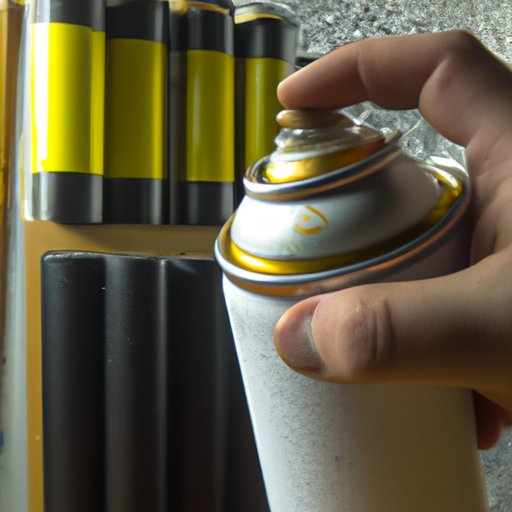Introduction
Spray paint art is the process of creating a painting using aerosol cans of spray paint. This unique art form has been around for decades, but it has recently gained in popularity due to its vibrant colors and unique textures. With a few simple supplies and a bit of practice, anyone can learn to create stunning works of art with spray paint.
Step-by-Step Guide to Creating Spray Paint Art
Creating a masterpiece with spray paint is easy if you know the basics. Here is a step-by-step guide to help you get started.
Gather Supplies
Before you start painting, make sure you have all the necessary supplies. You will need several cans of spray paint in different colors, a canvas or other surface to paint on, a drop cloth to protect your work area, and some protective gear such as goggles, gloves, and a respirator.
Prepare the Canvas
To ensure that your painting looks its best, you should prepare the canvas before you start painting. Start by wiping down the surface with a damp cloth to remove any dust or debris. If you are painting on a wooden surface, you may need to apply a coat of primer first. Once the surface is clean and dry, tape off any areas that you don’t want painted.
Select Colors
Choosing the right colors for your painting is key to creating a successful work of art. Consider the color wheel when selecting your colors and think about the desired effect you want to achieve. You may also want to consider the type of paint you are using and the surface material you are painting on.
Practice Techniques
Before you start painting, take some time to practice different techniques. Try stenciling, blending, and streaking to get a feel for how the paint behaves when sprayed onto the canvas. This will help you become comfortable with the process and will give you confidence when it comes time to start painting.
Begin Painting
Once you have gathered your supplies, prepared the canvas, selected colors, and practiced your techniques, you are ready to begin painting. Start by spraying light coats of paint in short bursts. Move quickly and evenly across the canvas, and be sure to keep your distance from the surface to avoid drips and splatters.
Tips and Tricks for Spraying Paint onto Canvas
Spray painting can be tricky, so here are a few tips and tricks to help you get the best results.
Use a Light Touch
When spraying paint onto a canvas, it is important to use a light touch. Too much pressure can cause the paint to splatter and run, resulting in an uneven finish. To avoid this, hold the can at least 10 inches away from the surface and move quickly.
Move Quickly and Evenly
When spraying paint, it is important to move quickly and evenly across the canvas. This will help ensure an even coverage and will prevent the paint from pooling in one area. Make sure to overlap each stroke slightly to ensure that no gaps are left.
Apply Multiple Coats
Applying multiple coats of paint is essential for getting the best results. Start with a light coat and then gradually build up the layers until you achieve the desired effect. This will help ensure that the color is even and will add depth to your painting.
An Introduction to Spray Paint Art Techniques
Once you have mastered the basics of spray painting, you may want to experiment with different techniques. Here are a few popular techniques that you can use to create unique and interesting works of art.
Stenciling
Stenciling is a great way to create intricate designs with spray paint. To do this, simply cut out a design on a piece of paper or cardboard and then place it over the canvas. Spray paint over the stencil and then carefully remove it to reveal your design.
Blending
Blending is a technique that involves mixing two or more colors together to create a new shade. To do this, start by spraying one color onto the canvas. Then, spray a second color in overlapping strokes to blend the two colors together. Keep practicing until you get the desired effect.
Streaking
Streaking is a technique that involves spraying paint in long, continuous lines. To create this effect, hold the can at an angle and move it slowly across the canvas. The result is a beautiful, streaky texture that adds depth and interest to the painting.
How to Choose the Right Colors for Your Spray Paint Art
Choosing the right colors for your painting is essential for creating a successful work of art. Here are a few tips to help you select the perfect shades.
Consider the Color Wheel
The color wheel is a great tool for choosing the right colors for your painting. You can use it to find complementary colors, create contrasting combinations, or just pick shades that look good together. Experiment with different color combinations to find the perfect palette for your painting.
Consider the Desired Effect
Think about the overall effect you want to achieve with your painting. Do you want to create a calming atmosphere? Or do you want something that pops? Selecting colors that fit the mood of your painting will help you create the desired effect.
Consider the Surface Material
The type of paint you use and the surface material you are painting on can both affect the final look of your painting. For example, certain types of paint may not adhere well to certain surfaces. Be sure to read the instructions on the paint can to make sure you are using the right type of paint for the job.

Choosing the Right Surface for Your Spray Paint Art
In addition to choosing the right colors, it is also important to choose the right surface for your painting. Here are a few things to consider when selecting a surface.
Consider the Type of Paint
Be sure to select a surface that is compatible with the type of paint you are using. Some paints only work on certain surfaces, so be sure to read the instructions on the paint can before making your selection.
Consider the Weight of the Material
The weight of the material you are painting on can affect the finished look of your painting. For example, a lightweight material may not be able to support the weight of the paint and could warp or sag. Heavier materials are generally better for supporting heavier layers of paint.
Consider the Texture of the Surface
The texture of the surface you are painting on can also affect the finished look of your painting. Smooth surfaces tend to produce smoother results, while rough surfaces can create interesting textures. Experiment with different surfaces to see which ones work best for your project.

Safety Tips for Spray Painting Artwork
Spray painting can be dangerous, so it is important to take safety precautions to protect yourself and your surroundings. Here are a few safety tips to keep in mind.
Wear Protective Gear
Make sure to wear protective gear such as goggles, gloves, and a respirator when spray painting. This will help protect your eyes and lungs from the fumes and particles in the air.
Ensure Adequate Ventilation
It is important to ensure that your workspace is adequately ventilated when spray painting. Open windows and doors to allow fresh air to circulate and use fans to direct the fumes away from your face.
Clean Up Immediately
Clean up any spills or splatters immediately to avoid slipping hazards. Wear rubber gloves and use a damp cloth to wipe up any messes. Also, make sure to dispose of empty paint cans properly.

Inspiration for Your Spray Paint Art Projects
If you’re looking for inspiration for your next spray paint art project, there are plenty of resources available. Visit your local art store to browse through their selection of spray paint art supplies. Research online galleries and blogs to find examples of spray paint artwork. And look at other works by spray paint artists to get an idea of what is possible with this medium.
Conclusion
Spray paint art is a fun and accessible way to create beautiful works of art. With a few simple supplies and a bit of practice, anyone can learn to create stunning paintings with spray paint. Follow the steps outlined in this guide to get started, and don’t forget to use safety measures to protect yourself and your surroundings.
(Note: Is this article not meeting your expectations? Do you have knowledge or insights to share? Unlock new opportunities and expand your reach by joining our authors team. Click Registration to join us and share your expertise with our readers.)
